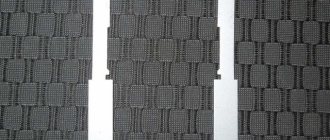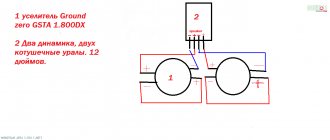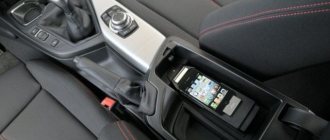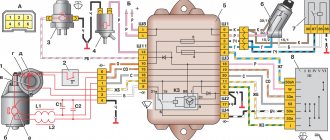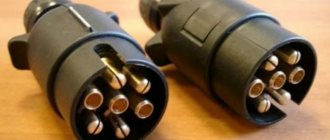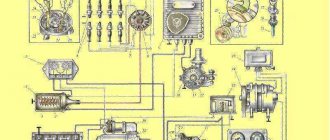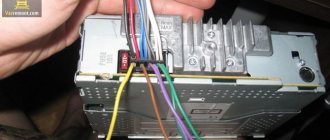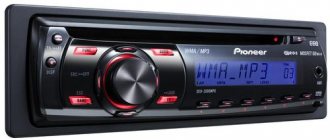The sound of the standard sound system, which is equipped with most cars, does not always satisfy owners with sound quality. In order to make the sound in the cabin louder and richer in bass frequencies, an amplifier and a low-frequency speaker are installed in the car. The connection diagram for a subwoofer and amplifier to a radio in a car is simple, but requires basic knowledge of electrical engineering. The standard radio is usually not replaced, but if necessary, the most modern system is installed. How to connect an amplifier and subwoofer in a car depends on the installation of new external devices. The low-frequency speaker can be installed on the rear seat parcel shelf. Such acoustics provide a comfortable sound background in the car interior. If the owner plans to install a 0.5-1.5 kW amplifier and the same loudspeaker, then the only place for the speaker system can only be the luggage compartment.
Connecting a subwoofer with an amplifier to the radio
To connect a subwoofer to a radio with an amplifier, you need to prepare the necessary components and tools. First, the location where the low-frequency system will be located is determined. Most often, the luggage compartment of a car is used to install a low-frequency unit. The low-frequency vehicle channel complex includes the following components:
- Car radio
- Battery
- Low frequency amplifier
- High capacity capacitor
- Bass powerful speaker
All these elements must be properly connected to each other. Power is supplied to the car radio in the standard way, so there is no need to change anything here. An important part of the installation of a low-frequency complex is the organization of power supply. The connection diagram for a subwoofer and an amplifier includes sending a sound signal from the car radio, connecting the power supply terminals to the battery and connecting the ULF output contacts to the speaker system. A low-frequency amplifier for a car is not like a household appliance. Usually this is a flat block in a metal case, on one of the walls of which there are coaxial “Tulip” type connectors for supplying an audio signal from an external source and screw terminals for connecting the supply voltage and speakers. In the connection diagram for the amplifier and subwoofer, a high-capacity capacitor is connected in parallel to the power terminals. It can be 0.5-2.0 farads. The storage capacitor functions as an additional power source.
When listening to music programs at high volumes, “dips” in the sound of the low-frequency system often occur. This is due to the fact that a car battery, at the peak power of a music system, cannot provide a large current consumption. In this case, the electrical energy stored in the capacitor is transferred to the ULF power supply circuit, ensuring normal sound. The amplifier and subwoofer are connected using a special cable designed for speaker systems. To connect elements of a low-frequency car kit, you cannot use ordinary SHVVP type wires from household equipment.
General view
Ratio between amplifier and speaker power
In the old days, a lot depended on the power of the amplifier, and buyers relied on this parameter when making their choice. The price of the acoustics also depended on the power of the amplifier (see How to connect an amplifier and subwoofer to a car radio: you are your own master), its quality. Technologies began to develop and power eventually ceased to be a fundamental criterion. Playback quality comes first.
Why do you need power?
Amplifier to speaker ratio
Below is information that will be useful for every connoisseur of good sound to know:
- The power of the amplifier directly affects the volume, but not only that. The device itself and its power cannot directly influence the volume of sound emitted by the speakers. And this component depends on the ratio of acoustics and amplifier.
- The acoustic component known to everyone today, called “sensitivity,” is measured in decibels and indicates what sound pressure a certain acoustic system can develop (at a distance of 1 meter from it).
- The usual sensitivity of modern speaker systems ranges from 83-105 decibels. A person during a quiet conversation emits a sound of 60 dB, loud rock music - 110 dB, but 120 dB or more already creates a real situation of complete loss of hearing for a person.
It is very important to measure the ratio of acoustics and amplifier at a distance of one meter, and not more or less. For example, a 3 W device paired with 105 dB acoustics will sound as loud as a 384 W amplifier with an acoustic sensitivity of 84 dB. When choosing this element of the system, you need to remember one more important rule: it must always have a power reserve. This will deprive the user of the inconvenient situation when it is necessary to turn the volume knob to the maximum, as a result of which, on some amplifiers, quite large sound distortions can be observed. If you imagine a rotator in the form of a clock (many modern devices do this), then a comfortable volume level should be achieved when rotating the rotary until 10-11 o’clock. All acoustic models can be divided into 2 large groups
This is a group where 4-ohm systems are collected and a group where 8-ohm systems are collected.
If you imagine a rotator in the form of a clock (many modern devices do this), then a comfortable volume level should be achieved when rotating the rotary until 10-11 o’clock. All acoustic models can be divided into 2 large groups. This is a group where 4-ohm systems are collected and a group where 8-ohm systems are collected.
Acoustics 6 ohm amplifier 8 ohm
For owners of 8-ohm acoustics, the ratio of parameters will not be particularly important. In this case, it is much better to concentrate your attention on the sound. On the contrary, those with 4-ohm systems would be wise to look at amplifiers that can double the power as the ohm drops. For example, such a device should output 100 W at 8 Ohms, and 200 W at 4 Ohms. At the same time, we must also not forget about the sound quality of the amplifier
Acoustics for marcantz amplifier
- Typically, 4-ohm acoustics are chosen by connoisseurs of bass and rhythmic music. When playing low frequencies, 8 ohm acoustics make the bass a little vague and indistinct.
- On the other hand, among amplifiers that do not double the power, there are much more devices worthy of attention in terms of build quality.
- All types of acoustics can also be divided into simple and complex, from the point of view of their relationship with the amplifier. This depends not only on the above factors, but also on such components as the size of the speakers, their design, etc. Complex types of speaker systems complicate the process of controlling the speakers for the device (see How to choose speakers for a car radio on your own). As you know, a good amplifier not only instantly sets the speaker cone in motion, but is also obliged to stop it when the signal stops.
Amplifier 8 ohm acoustics 6 ohm
Damping factor is the name given to an amplifier's ability to drive speaker cones. In more powerful devices, this parameter is usually better and has good current output.
In short, choosing the right amplifier is a real art.
How to connect wires to an amplifier and subwoofer
To properly connect the subwoofer and amplifier, you need to select the appropriate connecting wires. Acoustic cables for connecting elements of the low-frequency complex must be multi-core, made of copper and have a cross-section corresponding to the current consumption of the amplifier. You cannot use wires from some companies that have steel or aluminum cores coated with a thin layer of copper. This is especially dangerous with high power low-frequency sound systems. To connect the subwoofer to the amplifier, ready-made sets of connecting cables are used.
This set includes wires for connecting power from the battery, wires for the speaker system, coaxial cables for supplying a signal from the radio. The kit includes a fuse, bolt-on cable lugs and fasteners. When the power of the device is low, only “+” supply voltage is supplied to it. This cable must be connected through a fuse, which is located in the engine compartment next to the battery. The minus of the block starts at the vehicle's ground. If the power of the low-frequency system exceeds 500 watts, this connection scheme cannot be used and the voltage from the battery is supplied through two wires. To reliably connect a subwoofer through an amplifier, you need to carefully tighten all threaded connections, since constant vibration when the car is moving can lead to loss of contact and failure of the sound system.
Three-way front and subwoofer
The three-band front is designed to improve the impression of the audio system and increase the intensity of the sound, and the subwoofer is to correct the error in the lower register for fuller sound. Speakers in a three-way front reproduce sound louder and more accurately, since the emitters of the corresponding sound band have a narrow directivity. Each of them reproduces a narrower range, so the system's speakers are less loaded than with a "two-way front and subwoofer" design.
In practice, there are 2 popular implementations of this system: 1. Three-band front on passive crossovers. In it, special attention must be paid to the location of the speakers. The system setup is based on connecting the top of the subwoofer and the bottom of the midbass and setting the sensitivity of the amplifier input signal. 2. Channel amplification from the radio. The equipment has three pairs of preamplifiers, while four pairs are required to set up the system. It is necessary to resort to certain tricks: you should split the RCA midbass using 2 Y-splitters. Important! It is necessary to choose the right midbass RCA, since it is located approximately at the same distance from the driver with the subwoofer. Channel system setup is much more complicated than the 1st scheme discussed. When setting cutoffs for each type of speaker, it is necessary to take into account individual audio delays, tonal balance and crossover slopes. Without the appropriate knowledge and skills, it is impossible to achieve impeccable sound. Inexperienced car enthusiasts should use a microphone or seek professional help.
Connecting a subwoofer through an amplifier
How to properly connect a subwoofer through an amplifier with multiple channels. In order to get full and high-quality sound, it is not enough to use a single-channel low-frequency unit. In this case, only the bass channel will be able to provide good output power. In this case, the volume and quality of playback through standard acoustics will be noticeably worse. The optimal solution would be to use an ULF with several channels. In this case, you can connect the subwoofer to the car through an amplifier through one of the channels, and the rest will be used to drive the front and rear speakers. In order to ensure a clear division of the entire audio range into separate frequency bands, the car's speaker systems are connected to the amplifier through filters - crossovers. In this case, high frequencies are transmitted by tweeters, mid frequencies are processed through full-range speakers, and deep and rich bass is reproduced by a subwoofer through an amplifier.
The subwoofer is connected to the amplifier using an acoustic cable, which should have as little resistance as possible. This wire must be copper and stranded. The amplifier and subwoofer are connected to the radio using an interconnect cable. Since a low-current signal is transmitted through it, its cross-section is not as important as the cross-section of the supply wires and cables for connecting the speaker.
Settings
Before setting up the amplifier, you need to consider what devices will be used in the system.
If you do not use a subwoofer for acoustics (only 4 speakers), this scheme is considered the simplest. In this case, experts recommend setting the following parameters:
- Bass Boost (bass enhancement filter) - set to 0;
- Level (amplifier power indicator) - 0 (8V);
- Crossover Selector (responsible for switching the LP-AP-HP filter) - set its position to FLAT.
After such manipulations, you should adjust the radio. This can be done automatically by selecting the desired equalizer. It is possible to manually adjust the powerful and soft sound of the car radio. After turning on the song, the volume is set to 90%. At this time, the Level control on the amplifier is slowly scrolled and the position with the loudest and clearest sound is found. Bass Boost can be added.
If you have a subwoofer connected through an amplifier, a slightly different approach will be required. The sub is connected to Rear, and the speakers to Front. In this case, the indicators may be the following:
- Bass Boost - at level 0;
- Level - 0 (8V);
- Front - the Crossover Selector control should be in the HP position, while FI PASS can be left in the range of 50-80 Hz;
- Rear - the Crossover Selector indicator in this case is on LP, and LOW PASS is set to the level of 60-100 Hz.
Setting up the amplifier is done in the same way. It is important to adjust the sensitivity of the front and rear speakers.
Additional manipulations may be required if the car enthusiast decides to install a microphone for a Chinese radio or other equipment.
Connecting a subwoofer with an amplifier to the radio
How to connect a sub and amplifier to a radio depends on the design of the playback device. Most standard devices are equipped with connectors with blade contacts, which are used to connect built-in speakers. In addition, on the rear panel of the car radio there are connectors for the linear outputs of the left and right channels. They are designed for RCA or Tulip type plugs and are used to connect an external low frequency unit.
If a single-channel module is used, then to connect the subwoofer to the radio via an amplifier, you need to use an adapter. It sums the left and right channels to feed them to the input of the low-frequency block.
Connecting a subwoofer to a radio with an amplifier, in addition to switching the audio signal, involves turning on the power remotely. A separate wire is used for this. It extends from the block that is used to connect the built-in speaker systems and is labeled “Systemremotecontrol”. After turning on the car ignition and supplying power to the head unit (GU), a potential of + 12 volts is established on this wire. Low frequency units designed to work with car speaker systems have a contact that is marked in the same way. Connecting the contacts of the control unit and the amplifier ensures simultaneous power supply to both devices.
The connection diagram for a subwoofer and an amplifier in a car does not necessarily have to include automatic power supply. You can not use the remote control line, but install a regular toggle switch to turn on the power to the powerful low-frequency path manually.
What is line output
In order to connect the amplifier to the car radio, there must be linear outputs on the back wall of the player. Another name for such connectors is RCA outputs. To connect to audio equipment, a special cable is used, equipped at the ends with special plugs, popularly called tulips or bells.
There can be several tulip outputs on the radio, from one pair to three. There are advanced players that have more than three pairs of linear outputs. You can find out their number by looking at the technical specifications of your radio.
Line output
Connecting to the radio via tulips using linear outputs is considered very reliable, since the connecting parts fit very tightly to each other. But when choosing a cable with tulips, it is worth remembering that a high-quality cable will not be cheap.
Important to remember! Don't take cheap Chinese stampings, they won't last long. When purchasing, consider the length of the cable; it should be generous when connecting devices.
How to connect a sub to a radio via an amplifier
In order to equip a car with a high-quality sound system and connect a subwoofer with an amplifier to the car, you first need to select a low-frequency amplification system. Its type is determined by the requirements for sound reproduction. Car modules are of the following types:
- Single channel
- Dual channel
- Four-channel
- Five-channel
Units with one channel are used only for connecting a subwoofer. They can operate into loads up to 2 ohms. This system is easy to install and reliable. There is no bass boost control on the car radio, but there is one on the bass module, and you can always set the desired volume level. Two-channel systems allow the connection of two loudspeakers or one, but powerful speaker. The most popular models are four-channel systems. They allow you to connect a sub and amplifier to the radio and change the configuration of the car's sound system within a wide range. A device with five channels allows you to connect four speaker systems and a woofer. This is the most uneconomical model and when working in a parking lot, such a unit will quickly drain the battery.
Connecting a subwoofer with an amplifier to a car begins with choosing the installation location. The length of the connecting cables will depend on this. The diagram for connecting a subwoofer in a car through an amplifier requires calculating the length of the wires in advance, since the entire installation will be carried out under the casing. When installing the module, you need to know that this electronic unit will generate a large amount of heat during operation, so there must be normal air circulation at the installation site. When connecting a subwoofer to an amplifier in a car, you should avoid mounting the unit on its side or in any incorrect position. If the low-frequency unit is intended only for a subwoofer, then the best place to place it will be the luggage compartment, where the module is located next to the subwoofer. In this case, you will only need one positive power wire and an interconnect cable from the radio. Connecting a subwoofer to a radio with an amplifier photo.
Output functions for tulips
Oddly enough, it all depends on the cost of the equipment. The more expensive the radio, the richer its functionality. Accordingly, the number of RCA connectors will be greater in expensive models. Let's look at the purposes of different configurations of tulip outlets:
- a pair. It is practically present in all inexpensive players and is very convenient for connecting a subwoofer.
- two pairs. With two pairs of linear outputs, you can build a system of rear and front outputs. Such radios have an average price range. There is a possibility that they contain subwoofer settings with an HPF filter for adjusting low frequencies.
- three pairs. This is the best option. With this configuration, you can connect a complete set with an amplifier for all channels to the car radio. And if the radio has a built-in processor, then you can create a completely sophisticated audio system. But such a car radio will cost a lot of money.
So, if it makes sense to change the standard radio to a more advanced one, you should first decide what tasks it will have to face in the future.
How to Connect a Subwoofer Speaker to an Amplifier
The subwoofer speaker is connected to the amplifier using an acoustic cable, which is included in ready-made kits or purchased separately. It is best when the ULF and subwoofer are located nearby. This allows you to reduce the length of connecting wires to a minimum. This reduces cable losses. If the low-frequency module and subwoofer are located in the luggage compartment of the car, a storage capacitor is attached nearby, which will avoid sound dips at high power. When laying connecting cables inside vehicle compartments, you must use the existing technological holes. At the points of transition through metal surfaces, plastic bushings are placed on the wires to avoid damage to the insulation and short circuits.
Multi-way speaker systems.
Speaker systems differ in the number of frequency bands into which the amplifier's output signal is divided.
In single-way speaker systems, the entire output of the amplifier is sent to one or more identical speakers.
In two and three-way speakers, the amplifier signal is separated using passive filters that are located inside the speaker housing. Such systems use dynamic heads designed to reproduce a certain audio frequency band.
Speakers are divided into four groups: high-frequency, mid-frequency, low-frequency and full-range. By their name you can guess what frequency range they reproduce.
There are also multi-band speaker systems that do not contain bandpass filters. Such systems require a signal already divided into bands corresponding to the sound heads. In such cases, multi-band amplifiers or external filters (crossovers) are usually used.
Where to install
The question of where is the best place to install a sub can turn into a problem: a successful solution is directly related to the model range of the car. The main nuance comes down not only to the settings stage, but also to finding a place for the amplifier.
Owners of a minivan or hatchback often stop at the trunk, since it has exaggerated parameters. With any sedan the situation is a little more complicated: there the device needs to be connected through the armrests or fixed on the shelf in the back. A convertible will be considered the most uncomfortable body type: such cars have a limited trunk volume, and turning on the subwoofer can be a big nuisance from a technical standpoint.
Factors Affecting Amplifier Installation
– the device should not interfere with the driver and passengers, should not spoil the interior and should not take up much functional space;
– the amplifier must be screwed to the car body, and not to moving parts;
– the device must be well cooled, i.e. it should be located in a large space, not in a small box;
– wiring should be simple. The wiring of the speaker system must be in a separate harness from the main wires of the car.
Interesting! If you connect all the wires into one harness (main and music), then when the car is started, noise will be heard in the speakers.
Important points
In the end, we summarize all the main aspects that need to be observed in order to connect the amplifier correctly and safely:
- Select a power cable of sufficient cross-section, preferably with a margin.
- Select the correct fuse.
- All contacts must be stripped and tightly tightened or crimped (the larger the contact area, the better).
- Knock out quality copper wiring.
- Protect cables from damage with additional insulation.
- Lay acoustic and signal wiring as far as possible from the power supply.
- If you have several amplifiers and the minus is taken from the body, then make contact for all at one point.
- Make all connections on a de-energized system (positive terminal with battery removed).


